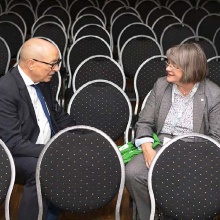The development of the Eurocodes has brought together experts from all over Europe. Professor Ulrike Kuhlmann, head of the Institute of Structural Design at the University of Stuttgart, with a focus on steel construction, timber construction and composite construction, talks about what the revision of the Eurocodes is all about and how the next generation can be given more support.
Ms. Kuhlmann, what influence does the 2nd generation of EC's have on teaching and on the steel construction industry?
The revision of the Eurocodes was aimed at achieving greater user-friendliness (keyword "Ease of Use"). At least in Eurocode 3, this has led to a clearer structure and to assistance in the form of flowcharts, which make it easier for both teachers and practitioners to deal with the standard. In addition, new research findings have been incorporated in a number of places, which I believe are important for the future of steel construction. I would like to mention as an example the consistent addition of all parts in Eurocode 3 for higher strength steels up to and including S700.
From your perspective, what will be the biggest challenges in the near future for teaching and students?
One of the major challenges in the near future is digitization. Even today, hardly anything is calculated "by hand". And digital implementation in design and production is already well advanced, see BIM. In principle, our students are also prepared for this and usually know how to use digital tools very well. The bigger challenge seems to me to be the lack of experience with the real workpiece and practice. By simply "calculating yourself" you also gain a "feeling" for the magnitude in the result. You can have a complicated connection drawn very well on paper, but whether you can build it is another question. How you manage to let students gain the necessary experience despite digitalization would be important for me to solve for the future.
What does this mean for cooperation between universities and the steel construction industry?
As I said, it would be good to find ways of working together, for example in the form of jointly supervised bachelor's or master's theses, so that students can gain practical experience; not to mention that experiencing how something new is built in practice and being involved in it can still also arouse pride and enthusiasm. Another important point for arousing interest among the younger generation is the concrete implementation of sustainability requirements. Resource conservation and climate protection are real concerns in this generation. Steel construction does not necessarily have the best image, which in my opinion cannot be improved with fine words alone, but credible concepts are needed.
From your personal perspective, what were the differences between the revision of Eurocode 3 and the 1st EC generation?
I myself was already part of the project team for the development of the standard now in force and can say that this was also a very positive experience of genuine European cooperation, in which one could benefit from the wealth of experience of the experts from the various countries involved. Now, for me, the process of revising and further developing the standard was not only a genuine European cooperation again, but this was characterized far more than the first time by transparency and democratic participation of a larger expert public. Comments were collected very systematically, not only on the standard now in force, but also on all intermediate stages of the newly developed drafts. In addition, there is an obligation to provide written, comprehensible reasons for all changes, whereas the first time around, background documentation only existed for the original preliminary drafts of the standard.
Which of the changes and innovations in the 2nd EC generation, specifically EC3 rewrite, are the biggest successes for you?
In the development of the 1st generation, there were many different competing approaches, especially for the stability proofs, not least due to a scientific "dispute" between different European research groups. We have actually succeeded in finding a common solution in all even traditionally different approaches. I am proud of this kind of concrete harmonization. Another important step for the future, in my opinion, is the new Part 1-14, which deals with steel structure design using FE calculation, not only for internal forces, but also for verification. And finally, we are now in the process of compiling rules for the evaluation of existing structures.
What will change for you personally in 2023?
I will be retiring as a professor at the university at the end of the year. This will mean that an important part of my life will change. This does not mean that I will "drop the pen completely", there will still be research and doctoral theses to finish, where my experience still helps, I will also support in standardization and I am, after all, still involved in my engineering office. But overall, it should become less and give me the chance to concentrate on topics that I enjoy and perhaps also relate to social issues beyond the engineering focus within the framework of my academy memberships.
Interview published in: Stahlbau verbindet 1 | 2023.
Übersetzt mit deepl


